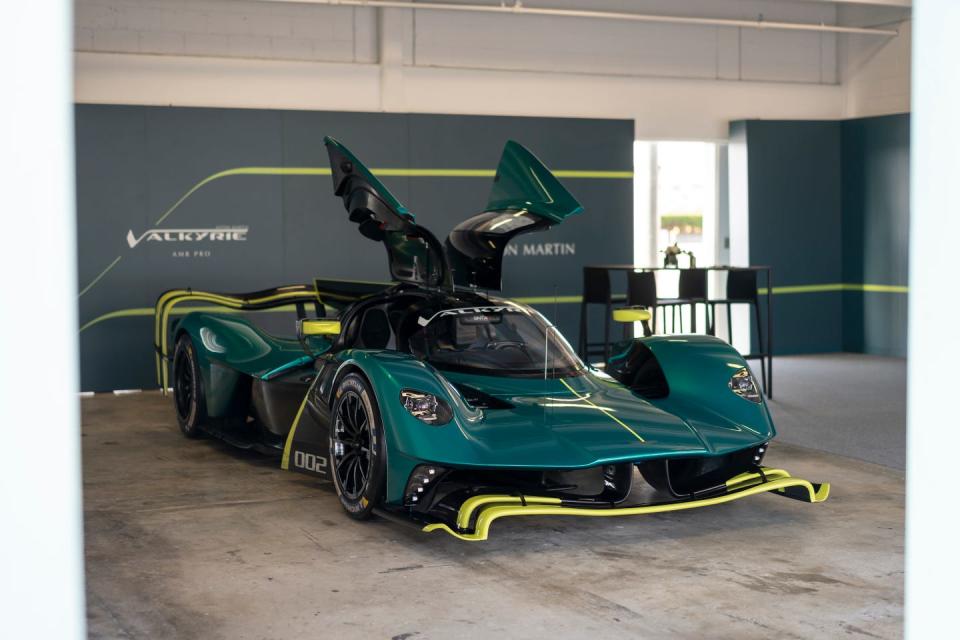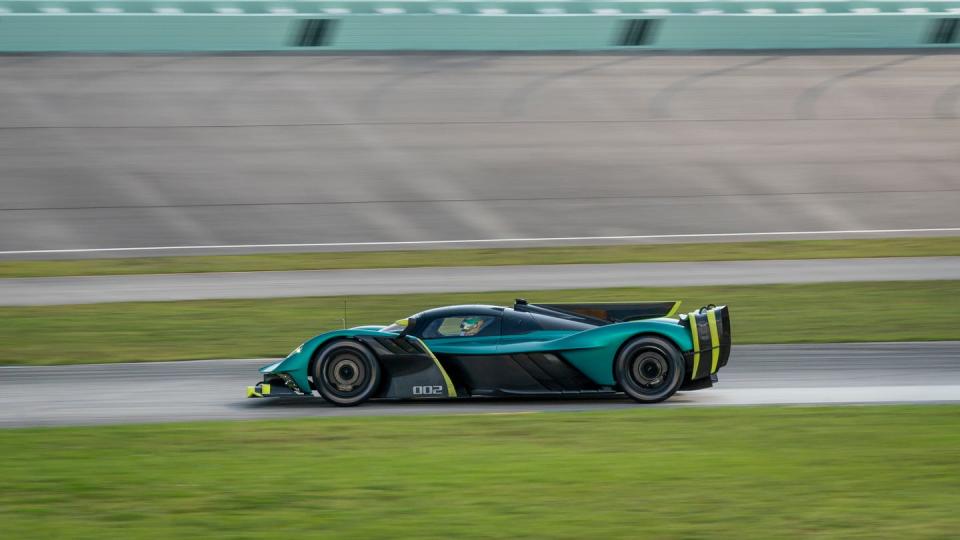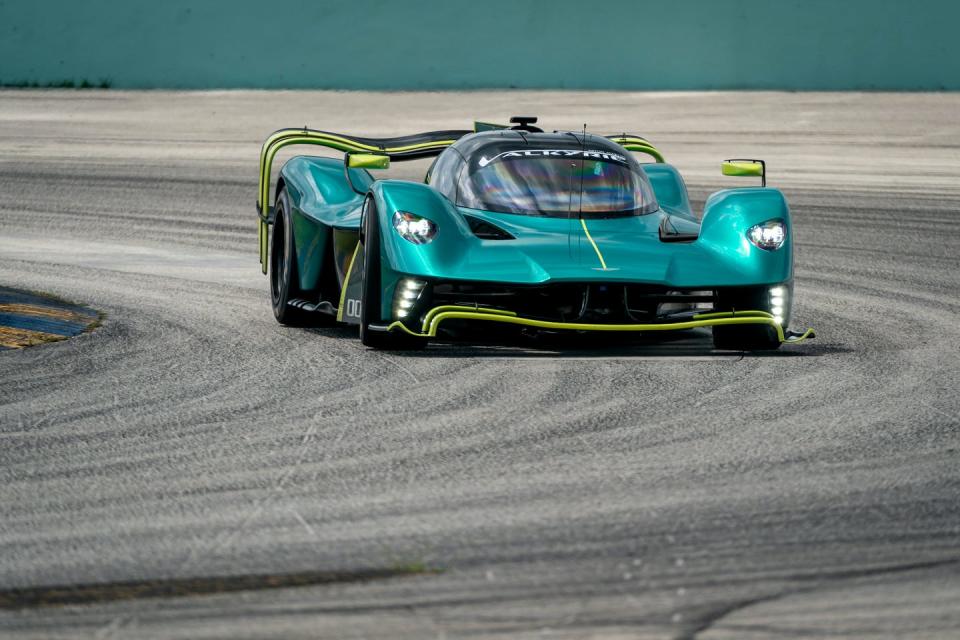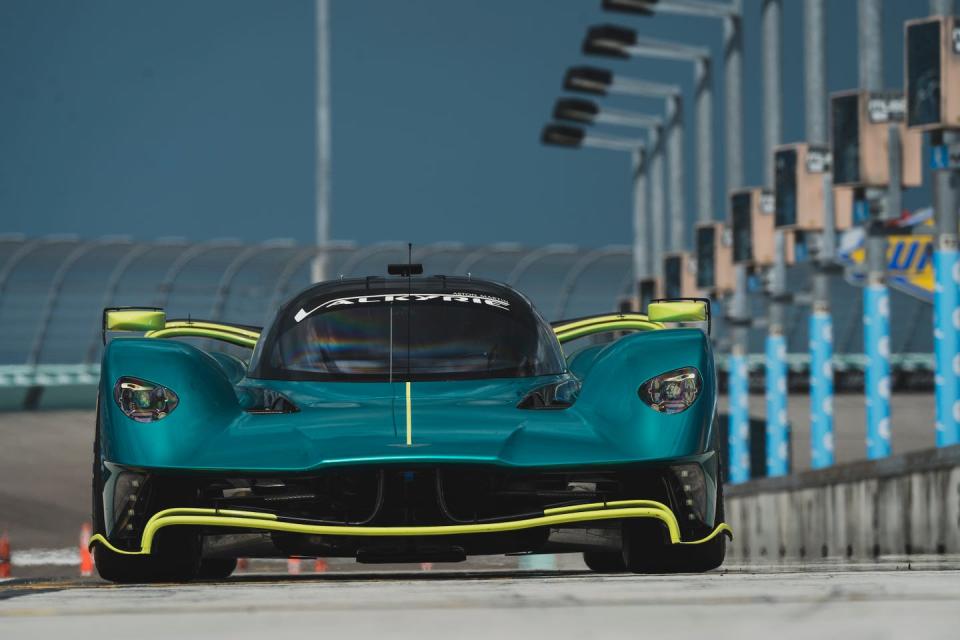The Aston Martin Valkyrie AMR Pro Is a Ludicrous, Glorious Thing

When Adrian Newey promised that the Aston Martin Valkyrie AMR Pro would be as fast as an LMP1 car around a circuit, there was open skepticism from many with a deep understanding of race car physics. Aston hasn’t released telemetry to confirm this claim yet, or a video of the Pro flashing its headlights at a front-end Le Mans car in its way. But having experienced it from its vestigial passenger seat, which is actually just padding stuck to the carbon tub, I can confirm that it feels painfully fast.
Giving journalists passenger rides in hotly anticipated new products has been a part of automotive PR for so long that Karl Benz probably invited some tame hacks for a ‘pre-drive’ in the Patent Motor Wagen. When it comes to quick cars the deal is a simple one – an experienced pro driver gives thrills and we get what is basically a rollercoaster experience. Granted, sometimes it goes a little wrong, but even then we tend to think it’s part of the fun.

Yet this is different. The AMR Pro’s stats are both as intimidating as they are unlikely. As with its street-legal sister, power comes from a 6.5-liter Cosworth-built V12 mounted directly to the back of the tub. Shorn of the road car’s hybrid system, this makes a claimed 1000hp at 11,000rpm and propels a car that, although we don’t have a formal weight figure, is under 2200lbs. We don’t have an official downforce figure either, but designer Adrian Newey promised that the Pro will be able to generate twice as much aerodynamic assistance as the regular car. Suggesting something in the region of a 6000lb peak.
Newey isn’t at the Homestead Miami Speedway as the AMR Pro is set to give journalists passenger laps for the first time. The long, long gestation of the Valkyrie project, and the fact Aston Martin has subsequently bought its own Formula 1 team, means that the erstwhile connection between Aston and Red Bull Racing which led to the Valkyrie’s creation has now become a slightly awkward non-topic. But Marek Reichmann, Aston’s creative director, is present – the man who made sure the finished car carries at least some of the brand’s visual DNA.
“The car was designed to keep the packaging as tight as possible around the constraints of a human being and an engine,” he says, “that’s it - there’s nothing else, we don’t have a millimeter of spare space. It’s almost exoskeletal in its design, the tub is the structure, there’s no cladding on it.”

Driving duties at Homestead are in the very safe hands of Andy Priaulx, former World Touring Car Champion and a works Ford WEC driver. He has been one of the AMR Pro development drivers since shortly after the program began, the work filling in as his professional motorsport career wound down. “To be honest I didn’t think I’d get the chance to drive anything as quick as this again,” he says. Apart from a couple of tests in what was a current Williams F1 car in 2005, he says this is the fastest thing he has driven.
With multiple journalists to get through, and the Florida sunshine getting hotter, Aston adopts a simple technique to ordering the turns: size descending. As one of the mechanics puts it, because it’s easier to tighten straps in the Valkyrie’s ultra-snug cockpit than it is to loosen them. It also means the car’s pace should increase as the quantity of human ballast being carried goes down. I’m third-up, so have the chance to watch from the pit wall as the AMR Pro heads out for its first two stints. It looks brutally fast as it streaks past on the start-finish straight – we’re on Homestead’s road course – but more striking is the howl from the naturally aspirated V12, this increasing well beyond the point my brain is expecting to hear it change up. All 11,000 revs are being used, even though I later discover the engine has been turned down on its selectable mode to only make 800hp. “More than plenty for here,” as Priaulx puts it.

Then it’s my turn. First discovery: there is no elegant way to get into a Valkyrie. The best way is to step over the huge sill and onto the seat before sliding downwards, this leading to a position that feels more like sitting on a bed than in a chair, ankles at the same height as backside. Room is predictably limited in the cabin; it will rarely have more than one occupant. To give Priaulx the space he needs to work the yoke-style steering wheel I have to fold my left arm across my body.
The AMR Pro sets off quietly, rolling on the power of its 48V starter-generator in a gentle mode intended for pitlane starts and reduced mechanical stress. (An electro-mechanical clutch does give the potential for aggressive starts on V12 power.) The engine fires into life at around 10mph and immediately fills the cabin with buzzing vibration, but my chance to experience it at lower revs last no longer than the pit exit; from that point onwards it spends the whole stint in close proximity to its redline, its short gearing making for multiple upshifts even on Homestead’s shorter straights.

There is less drama than I am expecting. I had a similar passenger ride in the road-legal Valkyrie at the Goodwood Festival of Speed last year, with Aston’s then CEO Tobias Moers driving. That was on road tires and a damp surface, with non-working traction control: the engine and the rear axle seemed to be engaged in violent combat for most of the run. But at Homestead the combination of slicks, a hot surface and working TC means that – although the V-12 sounds savage even through a helmet – there is almost no sense of slip. During my stint Priaulx has a single, immediately corrected rear-end breakaway in one of the slower turns, just to show he’s trying, but that’s the only slide I detect.
Yet the forces are enormous. Initial acceleration doesn’t feel much keener than a launch control start in a supercar, or a Tesla Model 3 Performance, although the the surge doesn’t seem to diminish any as speed rises. Braking is brutal, the Pro’s first full commitment stop making my carefully ratcheted harnesses feel suddenly loose. Cornering loads are even more punishing, and by the end of the first flying lap my neck muscles are struggling to support my head.

It feels like the world has had its playback speed turned up, even as Priaulx’s steering inputs remain calm and unhurried. All the stages of cornering seem to have been compressed: slowing, turning, accelerating out. The speeds feel subjectively impossible, even as the lack of drama proves that they are not. Well before returning to the pitlane, having sweated all the way through the Nomex suit in just four laps, I’ve reached the conclusion that Priaulx isn’t actually trying that hard.
“Yeah, about eight tenths maybe,” he confirms when I ask about his commitment level, “I’m doing this all day, remember. So is the car.”
Will any owners who have ponied up the $3.5m necessary to buy an AMR Pro be capable of driving it to any high percentage of its abilities? Will they even care?
It is a truly ludicrous car, it is also a glorious achievement.

You Might Also Like

